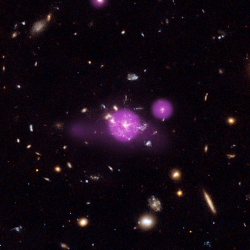HEAPOW: Growing the Cosmic Web (2022 Apr 18)
Posted: Tue Apr 19, 2022 10:51 pm
 HEAPOW: Growing the Cosmic Web (2022 Apr 18)
HEAPOW: Growing the Cosmic Web (2022 Apr 18)
Galaxy clusters are the largest identifiable objects in the Universe. These clusters contain dozens or hundreds of galaxies held together by the gravitational pull of their own dark matter. They form the strands that compose the cosmic web. But where do these strands come from? Looking back in time to the distant Universe, astronomers have identified clusters that are in the process of formation. But recognizing distant protoclusters in visible-band images can be challenging, since it can be hard to clearly identify cluster member galaxies from background or foreground galaxies (or even stars). X-ray observations can help identify member galaxies by detecting X-ray emission from supermassive accreting black holes in cluster member galaxies. The image above is an 8-day long Chandra X-ray Observatory observation showing the "Spiderweb" galaxy and its surroundings. The"Spiderweb" is an active galaxy which formed when the Universe was only about one-quarter of its current age. It contains an actively feeding supermassive black hole which powers radio-emitting charged particle jets stretching far into space. The X-ray image, shown in purple, is superimposed on optical images from the Hubble Space Telescope and the 27-foot wide Subaru telescope in Hawaii. The X-rays help pinpoint the location of actively feeding supermassive black holes that lie at the centers of 14 of the galaxies in the protocluster - an unusually large number. These observations help us understand how sticky strands of gravity in clusters in the early Universe like the "Spiderweb" trap wandering galaxies to form the large galaxy clusters we see around is, and power the growth of supermassive black holes.
| << Previous HEAPOW | High Energy Astrophysics Picture of the Week | Next HEAPOW >> |
